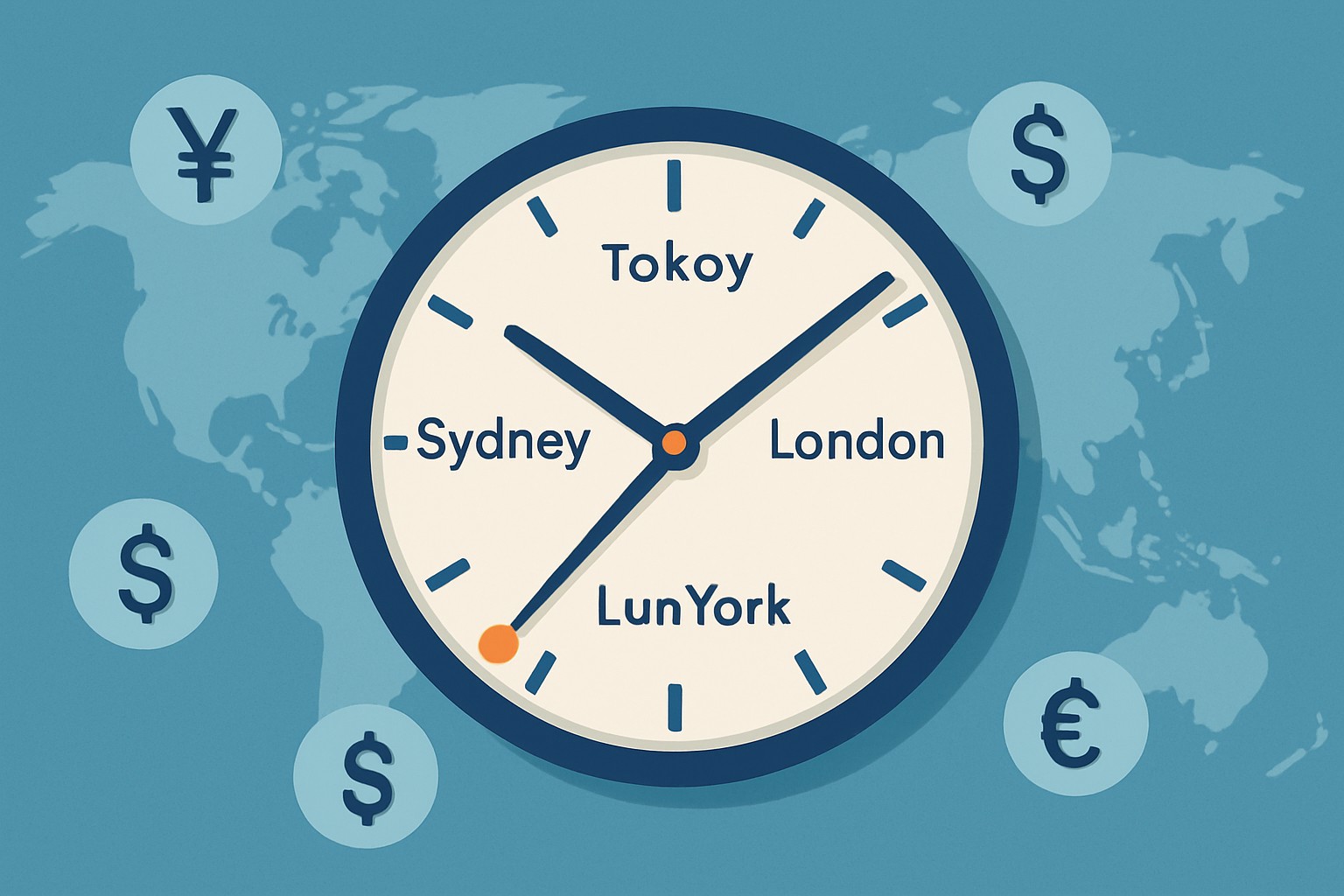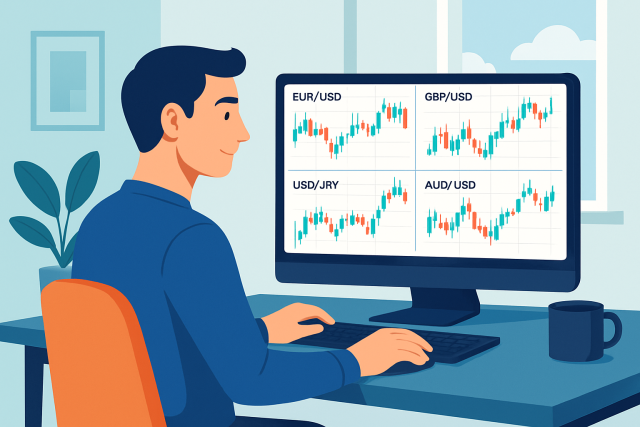
Forex For Beginners - What To Know Before You Trade?
New to forex? Discover essential insights, risks, and strategies in this beginner-friendly guide to...

The forex market stands tall as one of the largest and busiest financial markets across the globe, but its trading hours—commonly called forex market time—can sometimes feel like a bit of a maze for newbies. We walk through what forex market time actually means and why it’s something traders should care about.
Forex market time refers to the hours when currency trading is genuinely buzzing worldwide. Unlike stock markets that stick to their strict opening and closing hours, the forex market keeps humming along nonstop during the weekdays.
Knowing exactly when these sessions kick off and wrap up can be a real game changer for traders. It shines a light on those windows of high liquidity and volatility that often shape their trading moves.
The forex market is decentralized and operates through a worldwide network of banks, brokers and financial institutions. Because these players are scattered across different time zones, currency trading pretty much never takes a break during the weekdays.
The forex market operates around the clock on weekdays but takes a breather over the weekend. This pause mainly happens because the big financial institutions and markets in the countries involved shut their doors during that time, putting trading on hold. Think of it as the market catching its breath giving both traders and institutions a much-needed moment to prepare for what is coming down the pipeline, like important events and fresh economic reports.
The forex market is traditionally split into four main trading sessions tied to the world’s major financial hubs: Sydney, Tokyo, London and New York. Each session brings its own flavor with distinctive trading patterns and shifts in liquidity and volatility that keep traders on their toes.
| Session Name | Approximate Local Time | GMT Time | Key Markets Open | Typical Market Behavior |
|---|---|---|---|---|
| Sydney | 10:00 PM - 7:00 AM | 9:00 PM - 6:00 AM | Australia, New Zealand | Usually pretty calm and steady; liquidity tends to dip, with price moves taking their sweet time |
| Tokyo | 12:00 AM - 9:00 AM | 11:00 PM - 8:00 AM | Japan, Asia | Brings moderate liquidity to the table; Asian currency pairs often like to keep things lively |
| London | 8:00 AM - 5:00 PM | 7:00 AM - 4:00 PM | UK, Europe | Bustling with high liquidity and volatility; major pairs often put on quite the show |
| New York | 1:00 PM - 10:00 PM | 12:00 PM - 9:00 PM | USA, Canada | Famous for its high volatility; markets can jump at economic news like it’s their morning coffee |
This detailed session breakdown gives traders a solid roadmap to align their strategies with the market’s prime time, spotlighting exactly when certain currency pairs usually stir up the most action and liquidity.
The Sydney session kicks off the forex trading day and runs from 10:00 PM to 7:00 AM local time (AEST). Liquidity tends to be thinner than other sessions but it still plays a key role in setting the stage for what’s next. Currency pairs involving the Australian Dollar (AUD) and New Zealand Dollar (NZD) like AUD/USD and NZD/USD usually steal the spotlight during this time.
Ah, the Tokyo Session—where the action kicks off just as the city comes alive in a neon glow. It’s a time packed with energetic trading and fresh market moves that can really shake things up. Whether you’re an early bird or a night owl catching the tail end, this session never fails to bring its own unique flavor to the global market mix.
The Tokyo session runs from midnight to 9:00 AM local time (JST) and is often considered the beating heart of Asian trading hours. Liquidity here tends to be moderate with Japanese Yen (JPY) pairs like USD/JPY, EUR/JPY and GBP/JPY usually stealing the spotlight. You’ll often notice volatility picking up pace compared to the Sydney session especially around key economic announcements from Japan and other Asian countries.
The London session is often regarded as the beating heart of forex trading and runs from 8:00 AM to 5:00 PM local time (GMT/BST). It overlaps with both the Tokyo and New York sessions and usually stirs up high liquidity and volatility. Major currencies like the Euro (EUR), British Pound (GBP) and Swiss Franc (CHF) tend to come alive during this time.
The New York session runs from 1:00 PM to 10:00 PM local time (EST/EDT) and packs quite the punch on the global stage. It is often the wildest time of day for trading when the US Dollar (USD) grabs the spotlight. Big-ticket economic events like the US Non-Farm Payrolls and Federal Reserve announcements tend to send forex prices on a rollercoaster ride. Since this session overlaps with the London session early on, trading volumes usually hit the roof and stir up lively price action.
Overlap periods are hectic windows when two major trading sessions crash into each other and create the buzz with the busiest volumes, tighter spreads and a spike in volatility. The London-New York overlap steals the spotlight as the favorite among many traders. It is easy to see why because it serves up a smorgasbord of trading opportunities.
Forex is a global market that never really sleeps. Its trading sessions start and finish according to the local times of each financial hub. For example, the London session starts at 8:00 AM GMT but traders in New York or Tokyo have to convert those times into their own zones.
Trade effectively by converting session times to your local clock and keeping an eye on daylight saving changes they can sneakily shift session overlaps and liquidity windows.
Trading during the right forex market hours usually gives traders a leg up by delivering enough liquidity and more predictable volatility. Market responses also happen just when you need them.
Timing your trades just right in the forex market usually unlocks more opportunities, smoother price swings, and a better shot at nailing exactly what you’re after, all because the action tends to pick up when you least expect it.
Understanding the timing of the forex market can truly make or break your trading results. It’s usually a smart move to zero in on trades when liquidity is teeming, and to avoid those sleepy periods with low volume that tend to invite slippage like an uninvited guest.
Aim to trade during those sweet spot overlap sessions like London-New York, when liquidity is at its best and spreads usually tighten up nicely.
Keep a close watch on the economic calendar for major news releases during sessions because sudden volatility can shake things up when you least expect it.
Tailor your strategy based on how wild or tame the session typically runs. It’s better to play it safe during quiet spells and amp up the action when things get busy.
Make good use of demo accounts to fine-tune session-specific strategies. This is a great way to build confidence without risking any money.
Remember that weekend gaps can pose a risk, especially if you’re holding positions near the market’s closing bell.
Many new traders often get a bit tangled up when it comes to understanding how forex market hours actually work. Some jump to the conclusion that the market is open 24/7, thinking there’s always a chance to trade no matter the hour. Others assume every session hums along with the same energy or that trading outside the prime hours is a smart move.
23 articles published
Transforming the field of commodities trading through sustainable investing principles, she bridges traditional finance with ESG considerations.
Read Posts
New to forex? Discover essential insights, risks, and strategies in this beginner-friendly guide to...

Timing is critical in Forex trading. Learn how to trade during peak market sessions and overlaps to...

Discover a practical, step-by-step approach to start forex trading using essential tools like Tradin...

Leverage in forex allows traders to amplify their market exposure with limited capital. Understand h...
27 articles published
23 articles published
20 articles published
